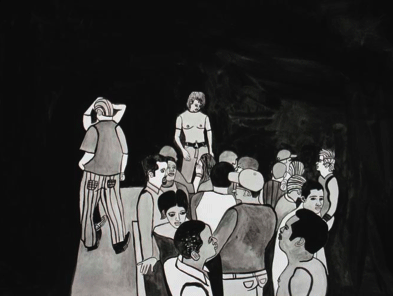
Born in Milwaukee, Wisconsin in 1973, video artist and musician Sadie Benning came of age in the art world in the 1990s with well-known journalesque-video tapes, experimental exposés made on the Fisher Price Pixelvision camera that her father, experimental filmmaker James Benning, had given her. Also a former member of the band Le Tigre, Benning is known for her bold and brazen style. Her works have previously shown in the Whitney Biennial in 1993 and in 2000. Her current installation Play Pause (2006), is also now on display at the Whitney.
Play Pause is a two channel video installation that projects images of thousands of hand drawn, gouache on paper, illustrations that Benning made between 2001-2006. Most of them are drawn in black and white with a light gray wash underneath, but a few of the images are also treated with a monochrome tint of red, blue, or green. The piece runs for 29 minutes on a loop. The illustrations were all scanned and arranged in this sequence for the piece. Coupled with surround sound, they tell a story of a “day in the life,” of an anonymous protagonist. Each image appears for only a few seconds, and then another similar image appears: from the first steps on the street, the stores, advertisements, shop fronts, anonymous people, night life, dance clubs, after hours sex, television, and scenes of departure from the train station and airport.

The title Play Pause alludes to the installation’s strange sense of detachment coupled with vulnerability. This tension arises in several ways: the rhythm and pace of the installation, the space itself, and the particular images displayed. The first juxtaposition occurs between the surround sound pulsing around slow and still images. The images are slowly animated, and only switch up every few seconds, while the sound, especially in the scenes featuring sports (baseball) or music, adds a vibrancy of movement, a “play.” There is one exception in the dance club, when the images are animated to match the music--changing red to blue to green and yellow, they pulsate at the same beat of the music. Beyond this exceptional scene, the pace of the piece normally levels on this strange pull between two worlds of moving and stopping.
The lines of the drawings are also demonstrative of this contradiction of play and pause. They are at once empty and vacant outlines, but by virtue of their hand-drawn quality, they are also personalized, unique and life-like. This play-pause tension resembles a kind of existentialism of the line—the anonymity of the public scenes treated with aloof lines, are transformed when they are treated with the lightness and carefree movement she uses to depict planes flying, people talking, or dancing. Together, these intimate moments, like the early journal entries in the Pixelvision pieces, receive the same reserved and careful treatment. Play Pause is on view at the Whitney until September 20, 2009.

